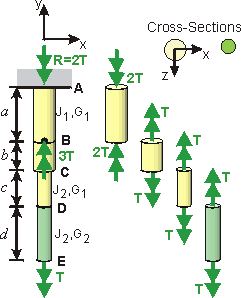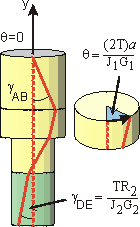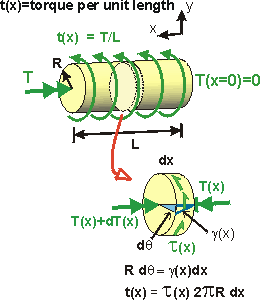Given: A stepped-shaft (polar moment of inertias J1, J2) made of two materials (shear moduli G1, G2). The shaft is fixed (no rotation) at the top. Torques are applied about the shaft's axis: 3T (counterclockwise about the +y-axis at Pt. B) and T (clockwise about the +y-axis at Pt. E).
Req'd: Determine the total angle of twist of the bar, qtotal.
Sol'n:
Step 1. Equilibrium.
Solve for the reaction at Pt. A: R = 2T (clockwise about +y-axis, a negative
torque).
Step 2. Twist/Torque of each Segment.
Break up the bar into segments over which all the values (torque, cross-section
and modulus) are constant.
The top segment, AB, has length, a, Polar Moment of Inertia, J1, modulus, G1, and supports torque 2T (a negative torque on the positive face of AB).
With Cross-section A fixed, the rotation of Section B with respect to fixed Section A is:
![]()
Taking each of the other segments with constant torque, section and modulus:
![]()
![]()
![]()
Step 3. Compatibility. The total angle of twist:
![]()

Free
Body Diagrams
of shaft segments.

Angular deflection of stepped-shaft.


